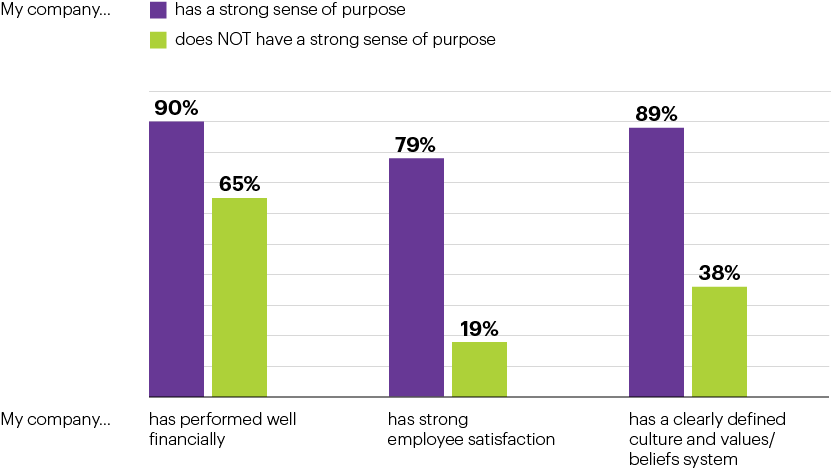In today’s world, there’s increasing awareness that companies need to operate for a higher purpose that stretches beyond making money and boosting shareholder value. Across the globe and within a vast array of industries, companies are demonstrating a compelling purpose is a valuable asset that is quickly becoming a business imperative, especially to attract and retain needed talent. When fully articulated and lived daily by leadership and their ranks, a purpose is something powerful that matters and enhances the value of a company.
What is this secret sauce?
A higher purpose is the single most distinguishing reason for the existence of an organization and the impact it seeks to make in the world. It is the over-arching reason for why a company does what it does. Once unearthed, a higher purpose should illuminate everything in its path. It should be an inspirational driver that defines and drives all organizational activities — innovation, creativity, policy, structure, culture, communication, processes, as well as performance, growth and change. At its best — clearly elucidated, authentic and aligned with a company’s business strategy, mission, vision, and values — it enables meaningful engagement with a business’s stakeholders: employees, customers, communities, vendors and regulatory agencies. It’s that engagement that ultimately impacts a company’s health and bottom line.
Benefits of a clear sense of purpose
Shared purpose boosts company health and performance in many ways.

John Kotter and James Heskett, “Corporate Culutre and Performance“
Deloitte’s Core Beliefs and Culture Survey and HBR’s The Business Case for Purpose Report are just two of the many research studies noting specific benefits for a higher purpose-driven company:
- Positively impacts the bottom line, yielding better performance and better financial returns
- Increases innovation and transformational change
- Helps companies with their strategy and new business development efforts
- Streamlined decision-making
- Helps an organization contribute to societal wellbeing and a more sustainable world
- Help brand recognition and relevancy
- Help drive positive brand changes
- Increases customer loyalty
- Helps attract and retain like-minded employees
- Increases employee engagement, providing a sense of meaning and fulfillment
- Increases willingness of teams to partner across functional and product boundaries
- Gives management criteria for performance evaluations and employee recognition programs
- Galvanizes employees to persevere through challenging situations
These results happen because organizations do better when everyone is rowing in the same direction. A well-integrated, higher purpose casts that direction. It becomes a true north on a compass guiding each employee’s daily actions.
It also is why the predominant characteristics of an organization with higher purpose are: focus, clarity, motivation and fulfillment. Today, to be a market leader and a company with a bright future, you need an organizational over-arching purpose.

Barriers to a clear sense of purpose
Although many leaders recognize the importance of a clear sense of purpose, there’s often a gap between that belief and the actual implementation of use within their organization. HBR’s The Business Case for Purpose Report notes,
“Although 90 percent of executives surveyed say their company understands the importance of such purpose, only 46 percent said it informs their strategic and operational decision-making.”
Many leaders are missing out on the full potential of a higher purpose within their company. In their book, “Corporate Culture and Performance”, John Kotter and James Heskett found that purpose-driven businesses with shared-values-based cultures enjoy 400% higher revenues, 700% greater job growth, 1,200% higher stock prices, and significantly faster profit performance, as compared to companies in similar industries that were focused on profit alone.
Some of the top hindrances leaders and corporations cite as barriers to a clear sense of organizational purpose include:
- Short-term shareholder pressure
- Lack of alignment of systems and infrastructure with long-term purpose
- Lack of clearly defined culture, value systems communicated clearly
- Lack of performance targets and incentives aligned with purpose
- Lack of meaningful metrics to track long-term value creation
- Poor communication and lack of its regularity from top leadership and management
- Lack of behavioral alignment among leadership and management
- Insufficient buy-in across organization
- Inability to break through message clutter
- Risk aversion and hyper-conservatism
- Academic focus versus emotional resonance
It’s sad so many leaders and companies fail to capture the enormous discretionary effort unleashed when an organization’s brand, people, and culture fully align with a higher purpose. At the same time, they fail to acknowledge the actual “cost” they are paying. In a company without purpose, people have only a short-lived idea of what they are supposed to do. Without a compelling narrative, a lot of ambiguity accompanies normal business functions — everything from creating a new product to onboarding a new hire. There is always activity and busyness, but it’s often frenetic, disorganized and focused solely on short-term goals. The lack of direction and long-term commitment gives employees nothing to believe in. When a company hasn’t made the effort to articulate why its employees should care, do you think as individuals they will?
A real example of shared purpose
KPMG provides a great case study in purpose as showcased in HBR. The accounting firm recently made employee engagement an organizational priority. As they began their work of articulating their higher purpose, one big challenge was clear — the need to do more than just announce the purpose but rather to create opportunities for employees to connect emotionally with this purpose and experience it fully themselves. They created opportunities for people to share their stories about the impact of their work. Giving people a chance to talk about the meaning of their work unleashed positive energy in the workplace. Every employee from receptionist to consultants to the people in the mailrooms shared their personal purpose that tied to the company’s overall purpose in some way. The outcome was magical that also made employees realize and appreciate how interconnected they all were in KPMG’s mission to serve its higher purpose.
The upshot of this initiative was impressive. 90% of respondents in the company’s annual partner survey reported that the higher purpose initiatives had increased people’s pride in KPMG. Additionally, KPMG’s improved morale boosted them up 17 spots on Fortune magazine’s annual 100 Best Companies to Work For list, making them the number one-ranked Big Four firm for the first time in company history.
Leaning into the challenge
Any company or leader will brush up against significant challenges on the road to defining an organizational purpose that truly informs strategic and operational decision-making. KPMG, for example, cites challenges like overcoming an academic focus and breaking through message clutter. Yet, the potential benefits are powerful and make the pursuit worthwhile. Increased employee engagement, customer loyalty, and profits are just a few of the benefits that can lie ahead for leaders and companies willing to journey toward a higher purpose. Others like — a driver of strategy, a recruitment tool and a way to make a difference in the world should make even a non-believer believe. Higher purpose mobilizes people in a way that pursuing profits alone never will. With purpose, a company creates positive value that is far greater than the sum of its parts. The truth is in today’s world a successful company truly needs to be built from the purpose up.
